Serviços Personalizados
Artigo
Links relacionados
Compartilhar
RSBO (Online)
versão On-line ISSN 1984-5685
RSBO (Online) vol.7 no.4 Joinville Dez. 2010
ORIGINAL RESEARCH ARTICLE
Evaluation of dentin cleansing by a detergent derived from castor oil (Ricinus communis) used as root canal irrigant: a scanning electron miscroscopy study
Letícia Molteni AguiarI; Lilian Eiko MaekawaII; Adriana ChungII; Maria Renata Giazzi NassriI
IDentistry Course, University of Mogi das Cruzes – Mogi das Cruzes – SP – Brazil
IIDepartment of Restorative Dentistry, School of Dentistry of São José dos Campos, São Paulo State University – São José dos Campos – SP – Brazil
ABSTRACT
INTRODUCTION AND OBJECTIVE: To evaluate, by scanning electron microscopy (SEM), the cleaning of root canal walls after biomechanical preparation and irrigation with castor oil (Endoquil®) and 0.5% sodium hypochlorite (NaOCl).
MATERIAL AND METHODS: Fifteen maxillary incisors were subjected to standardized root canal instrumentation with different irrigants (n = 5): G1 – Endoquil; G2 – 0.5% NaOCl; G3 – saline solution (control). After instrumentation, the teeth were prepared for SEM analysis (X 2000 original magnification) to evaluate the cleaning of cervical, middle and apical thirds. The area analyzed was quantified according to the percentage of open and closed tubules and data were statistically analyzed by ANOVA and Kruskal Wallis tests.
RESULTS: Statistical analysis showed that Endoquil was similar to 0.5% NaOCl at the apical third. However, there was statistically significant difference at the cervical and middle thirds, between these two groups.
CONCLUSION: It was concluded that Endoquil presented better results at the middle third while 0.5% NaOCl presented better results at the cervical third; at the apical third, both irrigants were similar.
Keywords: Ricinus communis; sodium hypochlorite; scanning electron microscopy.
Introduction
Endodontics is constituted by the triad: biomechanical preparation, microbial control and root canal obturation. The biomechanical preparation has two objectives, namely to complete the disinfection cycle of the root canal system and to shape the main root canal with appropriate and sequential instrumentation procedures combined with irrigants showing chemical-physical properties and antiseptic activity, promoting microbial control and root canal cleaning [1, 16].
The root canal irrigation aims to remove organic rests, smear layer, microorganisms or any chemical substances derived from the instrumentation process. Some authors reported the harmful action of the dentin plug on the apical healing [4, 6] and the presence of microorganisms at deep sites [9].
The auxiliary chemical substances used during root canal instrumentation play an extremely important coadjutant role in the disinfection of root canal regions that cannot be reached during biomechanical preparation [20]. The final cleaning of the main and accessory root canals directly influences the amount of remaining smear layer, which has a great influence on the adhesion of the obturation materials to the root canals [18].
Thus, some alternative irrigating solutions with antimicrobial action and biocompatibility have been proposed [7, 8, 23].
One of these substances is the castor oil, known as Endoquil (Poliquil, Polímeros Químicos LTDA., Araraquara, São Paulo, Brazil). This phytotherapeutic polymer is obtained from the seeds of the Ricinus communis plant. Considering the search for the ideal irrigant and following the guidelines of the World Health Organization, which recommends the use of animal, vegetal or mineral products, the utilization of a detergent derived from the Ricinus communis plant polymer at 10% has been suggested not only because of its excellent biological properties [2, 3], but also because of its antimicrobial activities, as demonstrated by Ferreira et al. [6], Leonardo et al. [9].
Motivated by the several endodontic irrigants available for clinicians and considering that the substance derived from the castor oil (ricinoleic acid) has been subject of several studies on different aspects [2, 3, 8, 10, 12, 17, 21], the aim of this study was to evaluate the root canal cleaning, since the higher the amount of remaining smear layer, the higher will be the risk of persistent infection.
Material and methods
Fifteen extracted intact maxillary human central incisors were selected from the Tooth Bank of the Dental Clinic of University of Mogi das Cruzes. All this bank's teeth are collected at the dental clinic after the achievement of patient consent. After recording, the teeth are available for utilization at classes, procedures or researches.
Radiographies were taken of all teeth to check any anatomical changes and standardize the specimens. Afterwards, the teeth were washed in tap water, autoclaved and hydrated in saline for one week before onset of the study. An access surgery was executed in all specimens using appropriate diamond burs, removing the entire dentinal remnant from the coronal pulp chamber for performing odontometry by the visual technique.
Then, the teeth were randomly divided in three groups:
• Group 1: Endoquil (Poliquil, Polímeros Químicos LTDA., Araraquara, São Paulo, Brazil);
• Group 2: 0.5% sodium hypochlorite (0.5% NaOCl) (positive control);
• Group 3: saline solution (negative control).
In all groups, the root canal biomechanical preparation was accomplished using appropriate endodontic instruments and K-type files (size 15 to 45), prioritizing the serial technique according to the anatomical conditions of the teeth. Root irrigation and suction was performed according to the auxiliary chemical substances, as defined in the experimental groups. A total of 5 ml of the irrigant was used at every change of instrument.
Twenty-four hours after the experimental process, the teeth were prepared for the analysis of results. Buccal and palatal grooves were made on the cervical region of each tooth to facilitate the transverse section, using a carborundum disc to remove the tooth crown completely. A second longitudinal section was made to separate the root in two parts.
For the scanning electron microscopy analysis, the specimens were dehydrated by immersion in increasing alcohol concentrations. After that, the specimens were kept in a bacteriological incubator at 37ºC overnight and then mounted on metallic supports for gold sputtering. The scanning electron microscopic analysis was made and photomicrographs were obtained at X2000 magnification.
The evaluation was performed by counting the quantity of open and closed dentinal tubules in each specimen of each study group, by visual method (figure 1).
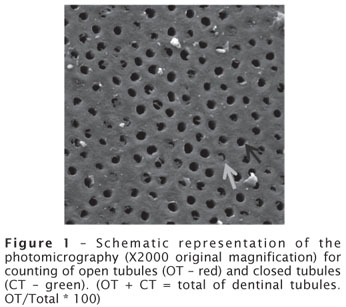
The collected data were analyzed as the mean of exposed dentinal tubules in each photomicrography and then organized and compared by statistical analysis.
The non-parametric Kruskall-Wallis test demonstrated no significant difference between groups irrigated with Endoquil and 0.5% NaOCl at the apical third, however, a statistically significant difference at 5% was observed at the cervical and middle thirds (table 1). Endoquil presented better results at the middle third compared to 0.5% NaOCl. Endoquil was statistically similar to control group at the cervical, middle, and apical thirds.
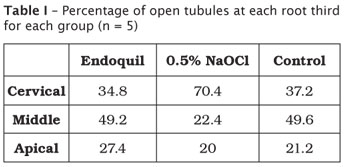
The photomicrographs below (figure 2-4) demonstrate representative SEM images of the cleaning obtained by the chemical substances used for biomechanical preparation in the different experimental groups (X2000 original magnification).
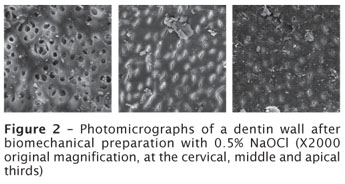
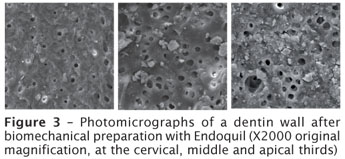
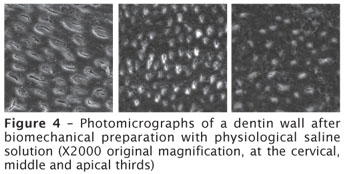
Discussion
The presence of bacteria in the root canal and surrounding regions is the main reason of endodontic treatment failure [22]. Although endodontic infection is a polymicrobial process, the predominance of anaerobic bacteria demands the integrally and satisfactorily removal of almost all microorganisms. To reach this point, it is necessary to prioritize the biomechanical preparation by the choice of the right technique associated to an auxiliary chemical substance that should have antimicrobial properties, organic and inorganic tissue solvents; be biologically compatible with the periapical tissues; and able to clean the main and accessory root canals [12]. This study evaluated the cleaning ability of Endoquil and 0.5% sodium hypochlorite. Both substances presented different behaviors when analyzed by scanning electron microscopy. Significant difference was observed between groups irrigated with Endoquil and 0.5% NaOCl at the cervical and middle thirds. However, both substances were similar at the apical third. Just few studies illustrate the objectives of this study. Similar results were found by Mônika and Fröner (2006) [13], where the authors verified that Ricinus communis gel was not an efficient root canal cleaning agent. Furthermore, no significant difference could be found between the middle and apical thirds of the roots. However, other investigations showed that the castor oil polymer presents satisfactory antimicrobial potential Ferreira et al. [6] and good biological compatibility Leonardo et al. [9].
The castor oil polymer has demonstrated biocompatibility and antimicrobial activity on Gram-positive bacteria and yeasts [2,3,5]. A study on teeth with pulp necrosis and periapical injury demonstrated that the castor oil detergent has antimicrobial activity similar to 0.5% sodium hypochlorite [5]. Derivatives of castor plant can be found as polyurethane polymers, detergents or gel. Endoquil is a detergent derived from 3% ricinoleic acid with antimicrobial action [8]. The world tendency to search for biodegradable, non-pollutants and biomass derivative materials has encouraged the development of studies on polyurethanes derived from the castor oil polymer, offering new perspectives for its development. Thus, new products with different applications, such as Endoquil, are being studied as root canal irrigants [13].
Several chemical substances have been used as irrigants during biomechanical preparation. Due to several properties, such as the capacity to dissolve organic material, lubricating action, neutralization of toxic content and antimicrobial activity, sodium hypochlorite is currently the most used substance during root canal instrumentation and irrigation [11, 19, 24]. However, its use at high concentrations can cause irritation to periapical tissues [14]. The sodium hypochlorite is a strong alkaline solution with two main characteristics: ability of pulp tissue dissolution, due to its high alkalinity; and germicidal property, which is related to the formation of hypochlorous acid and active chlorine release. The antimicrobial action of this acid occurs due to the oxidation of bacterial enzymes, which disorganizes its metabolism [19]. On one hand, the higher the concentration, the better it will be the antimicrobial effect. On the other hand, it must be carefully used to avoid its contact with the periapical region, causing serious inflammatory reactions. Conversely, the lowest concentrations can considerably reduce its disinfection power, although well accepted by the tissues [19].
Conclusion
After data analysis, it was possible to conclude that Endoquil presented better results at the middle third, while 0.5% NaOCl presented better results at the cervical third, and both irrigants were similar at the apical third. However, further studies are necessary to indicate Endoquil during the root canal biomechanical preparation in the endodontic treatment.
References
1. Câmara AC, Albuquerque MM, Aguiar CM, Barros Correia AC. In vitro antimicrobial activity of 0.5%, 1%, and 2.5% sodium hypochlorite in root canals instrumented with the ProTaper Universal system. Oral Surg Oral Med Oral Pathol Oral Radiol Endod. 2009;108(2):55-61. [ Links ]
2. Camargo CH, Camargo SE, Valera MC, Hiller KA, Schmalz G, Schweikl H. The induction of cytotoxicity, oxidative stress, and genotoxicity by root canal sealers in mammalian cells. Oral Surg Oral Med Oral Pathol Oral Radiol Endod. 2009 Dec;108(6):952-60. [ Links ]
3. Camargo SE, Camargo CH, Hiller KA, Rode SM, Schweikl H, Schmalz G. Cytotoxicity and genotoxicity of pulp capping materials in two cell lines. Int Endod J. 2009 Mar;42(3):227-37. [ Links ]
4. Camargo SE, Camargo CH, Hiller KA, Rode SM, Schweikl H, Schmalz G. Cytotoxicity and genotoxicity of pulp capping materials in two cell lines. Int Endod J. 2009 Mar;42(3):227-37. [ Links ]
5. ElDeeb ME, Thuc-Quyen NT, Jensen JR. The dentinal plug: its effect on confining substances to the canal and on the apical seal. J Endod. 1983;9(9):355-9. [ Links ]
6. Ferreira CN, Bonifácio KC, Froner IC, Ito IY. Evaluation of the antimicrobial activity of three irrigating solutions in test with pulpal necrosis. Braz Dent J. 1999;10:15-21. [ Links ]
7. Holland R, Souza V, Nery MJ, Mello W, Bernabé PFE, Otoboni Filho JA. Tissue reactions following apical plugging of the root canal with infected dentin chips. A histologic study in dogs' teeth. Oral Surg Oral Med Oral Pathol. 1980;49(4):366-9. [ Links ]
8. Jeansonne MJ, White RR. A comparasion of 2.0% chlorhexidine gluconate and 5.25% sodium hypochlorite as antimicrobial endodontic irrigants. J Endod. 1994;20(6):276-8. [ Links ]
9. Leonardo MR, Silva LA, Tanomaru Filho M, Bonifácio KC, Ito, IY. In vitro evaluation of the antimicrobial activity of a castor oil- based irrigant. J Endod. 2001;27(12):717-9. [ Links ]
10. Mader CL, Baumgartner JC, Peters DD. Scanning electron microscopic investigation of the smeared layer on the root canal walls. J Endod. 1984;10(10):477-83. [ Links ]
11. Martins GR, Carvalho CA, Valera MC, Oliveira LD, Buso L, Carvalho AS. Sealing ability of castor oil polymer as a root-end filling material. J Appl Oral Sci. 2009 May-Jun;17(3):220-3. [ Links ]
12. Menezes MM, Valera MC, Koga-Ito CY, Camargo CHR, Mancini MNG. In vitro evaluation of the effectiveness of irrigants and intracanal medicaments on microorganisms within root canals. Int Endod J. 2004;37(5):311-9. [ Links ]
13. Mônika CM, Fröner IC. A scanning electron microscopic evaluation of different root canal irrigation regimens. Braz Oral Res. 2006;20(3):235-40. [ Links ]
14. Oliveira DP, Teixeira FB, Ferraz CCR, Zaia AA, Gomes BPFA, Souza-Filho FJ. Remoção de smear layer dos canais radiculares utilizando o irrigante Endoquil. RBO. 2001;58:424-6. [ Links ]
15. Önçag Ö, Hosgör M, Hilmioglu S, Zekioglu O, Ernat C, Burhanologlu D. Comparison of antibacterial and toxic effect of various root canal irrigants. Int Endod J. 2003;26(6):423-32. [ Links ]
16. Pécora JD, Souza Neto MD, Estrela C. Soluções auxiliares do preparo do canal radicular/Auxiliares solutions of root canal preparation. In: Estrela C, Figueiredo JAP. Endodontia: princípios biológicos e mecânicos. São Paulo: Artes Médicas; 1999. [ Links ]
17. Penesis VA, Fitzgerald PI, Fayad MI, Wenckus CS, BeGole EA, Johnson BR. Outcome of one-visit and two-visit endodontic treatment of necrotic teeth with apical periodontitis: a randomized controlled trial with one-year evaluation. J Endod. 2008;34(3):251-7. [ Links ]
18. Pinheiro CR, Guinesi AS, Pizzolitto AC, Bonetti-Filho I. In vitro antimicrobial activity of Acroseal, Polifil and Epiphany against Enterococcus faecalis. Braz Dent J. 2009;20(2):107-11. [ Links ]
19. Romani NF, Carlik J, Massafelli M, Canepa R, Gentil S, Oliveira S. Atlas de técnica e clínica endodôntica. São Paulo: Roca; 1999. [ Links ]
20. Siqueira Junior JF, Rôças IN, Santos SR, Lima KC, Magalhães FA, Uzeda M. Efficacy of instrumentation techniques and irrigation regimens in reducing the bacterial population within root canals. J Endod. 2002;28(3):181-4. [ Links ]
21. Siqueira Junior JF, Rôças IS, Favieri A, Lima KC. Chemomechanical reduction of the bacterial population in the root canal after instrumentation and irrigation with 1%, 2,5% and 5,25% sodium hypoclorite. J Endod. 2000;26(6):331-4. [ Links ]
22. Souza EM, Wu MK, Shemesh H, Bonetti-Filho I, Wesselink PR. Comparability of results from two leakage models. Oral Surg Oral Med Oral Pathol Oral Radiol Endod. 2008;106(2):309-13. [ Links ]
23. Sundqvist G, Johansson E, Sjogren V. Prevalence of black-pigmented bacterioides species in root canal infections. J Endod. 1999;15(1):13-9. [ Links ]
24. Tanomaru Filho M, Leonardo MR, Silva LAB, Anibal FF, Faccioli LH. Inflammatory response to different endodontic irrigation solutions. Int Endod J. 2002;35(9):735-9. [ Links ]
25. Valera MC, Rego JM, Jorge AOC. Effect of sodium hypochlorite and five intracanal medications on Candida albicans in root canals. J Endod. 2001;27(6):401-8. [ Links ]
 Corresponding author:
Corresponding author:
Lilian Eiko Maekawa
692 Evolução St. – Vila Brasilina
ZIP code 04163-001 – São Paulo – SP
E-mail: lilian.maekawa@uol.com.br
Received for publication: April 4, 2010.
Accepted for publication: May 13, 2010.













